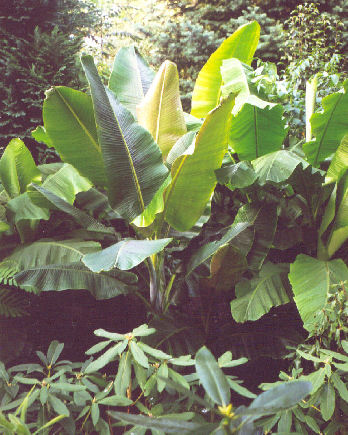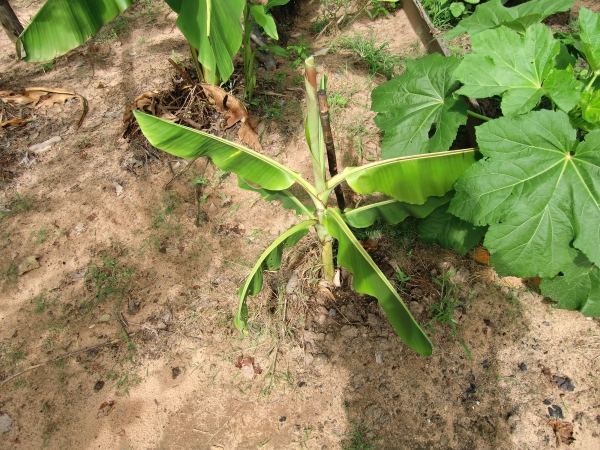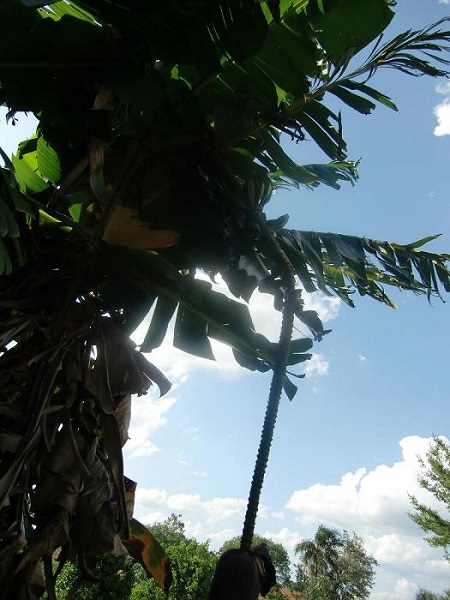

Musa sikkimensis (syn. hookerii, saptientum ssp. seminifera var. hookerii)
Darjeeling Banana, Sikkim Banana
It is a matter of one cold hardy banana species of the section Musa from Northeastern India, which was introducted only in the ‘90s into the outdoor culture. At the natural site grows Musa sikkimensis in the Himalayan Mountains into the altitudes of 7.333 feet and in the mountains in the north of Thailand, where snow and frost are occuring in the winter. It grows very large under favorable conditions, the pseudotrunk can reach one height of to 15 feet and the diameter can reach 1 ½ feet. The leaves can be as long and wide as the of Musa basjoo, which will make then one total height of approx. 20 to 24 feet. as dann eine Gesamthöhe von ca. 6 bis 7 Meter ausmacht. At first appearance too huge, but it grows probably not so huge in Germany and other cold areas, only to 10 to 17 feet, because it always dies back again and regrows from the corms. The younger leaves are reddish colored, at the same the pseudotrunk. Also the midrib is reddish. Selected seedling clones with reddish spotted leaves are existing, which could be one hardy alternative for the not hardy similar Musa acuminata ssp. zebrina. The most known and best is the cultivar Musa sikkimensis ‚Red Tiger’, seeds and plants from this cultivar are available by now. But not all of the seedlings of this cultivar have the typical leaf drawing. Further similar cultivars and provenances like Musa sikkimensis ‚Red Flash’ and ‚Manipur’ are available as seeds and plants.
The fruits are edible and sweet, but full of seeds, you have to be carefully in eating, because the seeds are hard-shelled. Currently no seedless cultivars of Musa sikkimensis are known yet, which are hardy at the same. Such cultivars might probably the first fruit bananas with the hardiness of Musa basjoo. One can grow this species easily from seed. Seeds is easily to find at the market in the difference of Musa basjoo. We also have plants grown from seed by Frutas Raras.
The corms are amazingly hardy, to 10°F, this have experiences in Belgium in one unheated greenhouse shown, where they have survived in the perished condition (Penninckx, pers. notice). Despite of this is one mulch layer for this species like Musa basjoo recommened, because there are no experiences with extreme winters yet. There are good experiences with the hardiness in the U.S.A., U.K., Germany, Switzerland and Austria in milder areas, however of all with provenances of high altitudes in the mountains Tropical provenances from the deeper altitudes have proven in many cases as less hardy. Therefore it’s also important to watch out of provenances to cultivate Musa sikkimensis outdoors all year round.
The American experiences shown that Musa sikkimensis needs some more warmth to come back than Musa basjoo after overwintering, it regularly regrows some later than Musa basjoo in the spring.
Three specimens of the regulary species and one of the provenance Musa sikkimensis 'Manipur' Helton Josué brought me on 16th September 2009 and I planted them on the next day out. Unfortunately they did not well in the sandy soil. In red soil, in Terra Preta and also in the special garden they might thrive much better. In the nursery of Helton Josué in Angatuba there are huge mother plants which are already flowering, fruiting and setting seeds!

Musa sikkimensis in my former garden in Hamburg/Germany
in 2003.

Musa sikkimensis 'Manipur' in the new garden in Lucianópolis/Brazil in December 2009.

Musa sikkimensis 'Manipur' in Angatuba at Colecionando Frutas
on
October 22nd, 2012.
Updated by Joachim Jaeck on October 10th, 2013